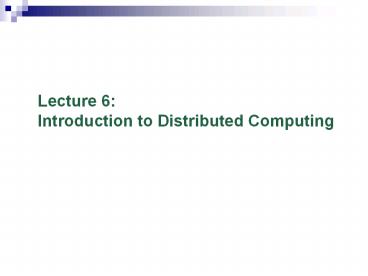Introduction%20to%20Distributed%20Computing - PowerPoint PPT Presentation
Title:
Introduction%20to%20Distributed%20Computing
Description:
Lecture 6: Introduction to Distributed Computing Distribute Systems and Distributed Computing Contents Introduction of Distributed Systems Distributed Computation ... – PowerPoint PPT presentation
Number of Views:136
Avg rating:3.0/5.0
Title: Introduction%20to%20Distributed%20Computing
1
Lecture 6 Introduction to Distributed Computing
2
Distribute Systems and Distributed Computing
Wei Chen, Professor Tennessee State University
- Contents
- Introduction of Distributed Systems
- Distributed Computation Models
- Synchronous Network Algorithms
- Asynchronous Network Algorithms
- Clock in Asynchronous Distributed Systems and
Snapshot algorithms - Fault-Tolerant Algorithms
3
Construction of Distributed Systems
- Units of A Distributed System
- Units/Nodes (Computers, sensors, )
- Network
- Software
4
What Is Distribute Systems?
- There is no unique definition for distributed
systems. Similar terms are - Networked system
- parallel systems
- Concurrent systems
- Decentralized systems
Enslows Definition Distributed System
Distributed hardware Distributed control
Distributed data
5
Distributed Hardware
Physically shared/distributed memory and
logically shared/distributed memory
Logically shared Logically distributed
Physically shared Common memory Simulated message passing
Physically distributed Distributed shared memory message passing
6
- Distributed System Software
- Cooperating the actions of units (computers,
sensors, ) - Supporting system resources (hard ware and
software) sharing. - Supporting data sharing.
7
- Distributed Control
- Master/Slave (fixed/dynamic)
- Multi control points (homogenous/heterogeneous)
- Distributed Data
- Copies Processors hold data copies.
- Divided data Data are divided and distributed
to processors.
8
Features of Distributed Systems
- Resource sharing hardware, software, data
- Openness openness of main interface of the
system, scalability of the current system - Concurrency concurrent execution of the
processes, high performance, nice rate of price
and performance (PC cluster poor mans
supercomputer ) - Fault tolerance ability to tolerate the fault
of system units, availability( using potential
redundancy to overcome the system fault). - Transparency a distributed system can be looked
as one computer (access transparency, position
transparency, parallel transparency,.)
9
Distributed Computational models
- Processes never mind in which unit they are.
- Communicating links communication channels
10
- Process
- Generalized RAM (Random Access Machine)
- CPU with program
- Infinite memory
- Message changeable with adjacent processes
- Each process has a distinct ID.
- Without fault (it will be considered in the
model with fault).
11
- Communication Links
- Bidirectional
- Asynchronous
- Infinite FIFO queue
- Without fault (no massage losing, alteration)
12
- Synchronism
- Running speed of each process
- Transmission delay
- Speed of the local clock in each process
constant upper and lower bounds
13
Local Clock of Synchronous Distribute Systems
p(t) the value of the local clock of process p
at moment t
Typical synchronous distributed model Round Model
- Processes execute each round synchronously
- Each round consists of message receiving,
computation, and - message sending
- Processes accept the message sent from the
previous round.
14
- Complete asynchronous model
- No assumption for the speed of processes.
- No assumption for the transmission delay of
communication links. - No assumption for the speed of local clocks.































